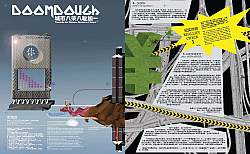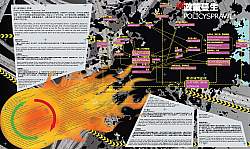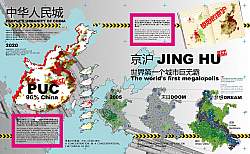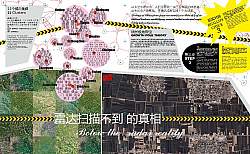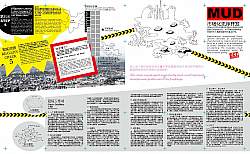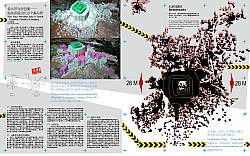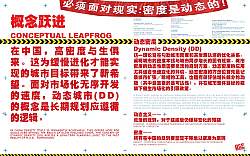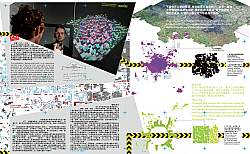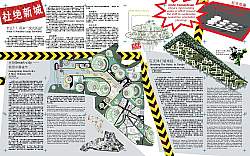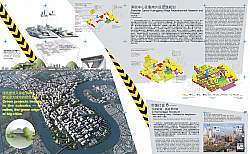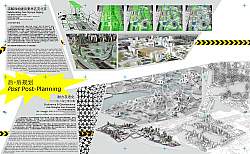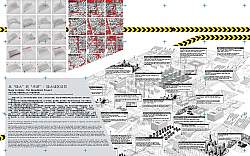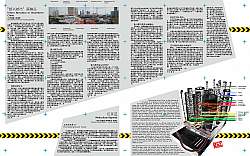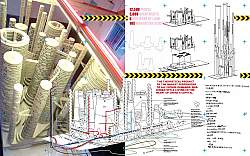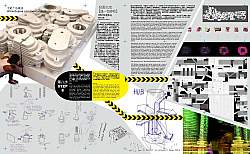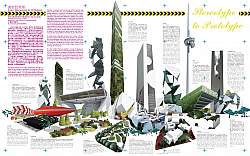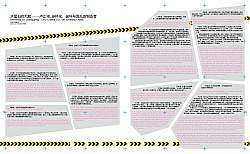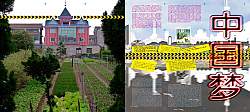Guest Editing Urban China Magazine
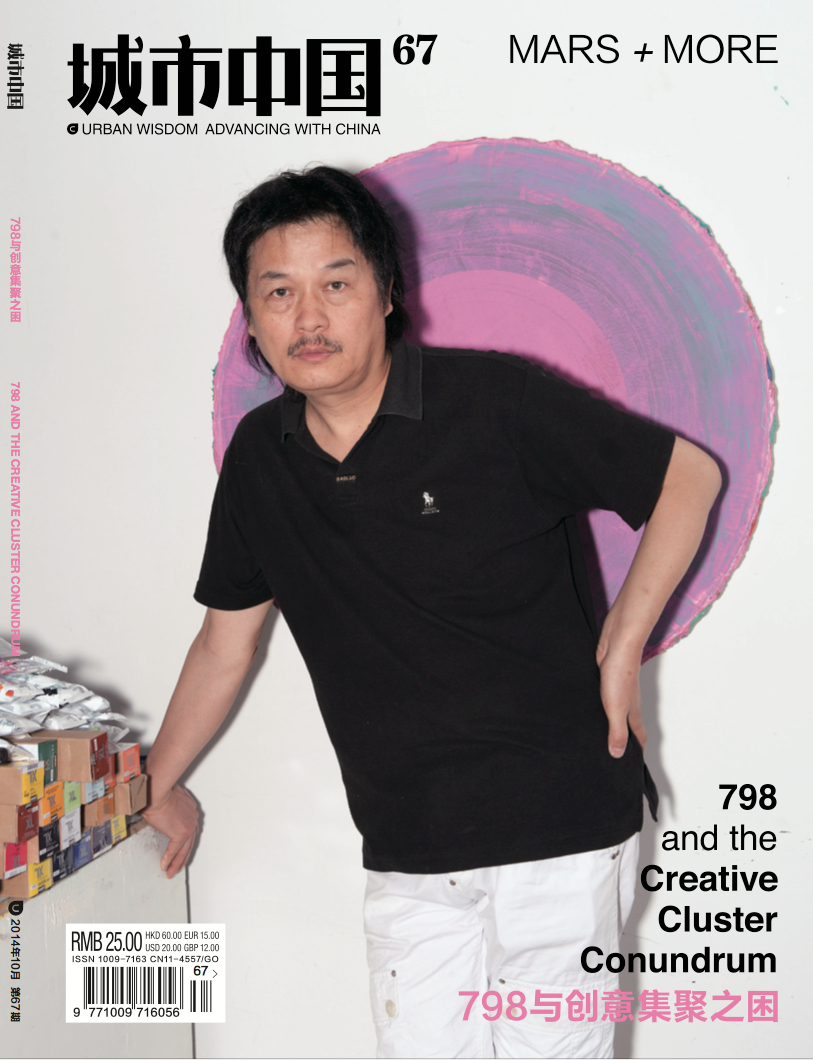
Urban China #67
798 and the Creative Cluster Conundrum is the second issue for which MARS Architects was invited as guest editor, this time together with MORE.
Chinese cities face a new urgency: to move away from the mass production of built space, and instead nurture the rise of healthy, diverse and creative urban centers. To this end, creative clusters are a pivotal planning tool. Creative districts the world over have been able to assimilate into existing urban fabric and effectively reinvent themselves as interesting, comfortable and profitable destinations. However, in China, its most renowned creative zone, the 798 Art District in Beijing, has become a victim of its own success. Emerged at the hight of China's economic boom, its accelerated gentrification has spiraled out of control. In a matter of years the area has converted from factory compound, to art district, to a loose-fit assembly of galleries and coffeeshops. After a decade and a half, it is legitimized and has the resources to plan more commercial developments. What is lost, during this period, however, is the involvement of a dedicated art community that can ensure new buildings contain and generate creative content. The challenge: ‘Can we plan what was essentially unplanned?’
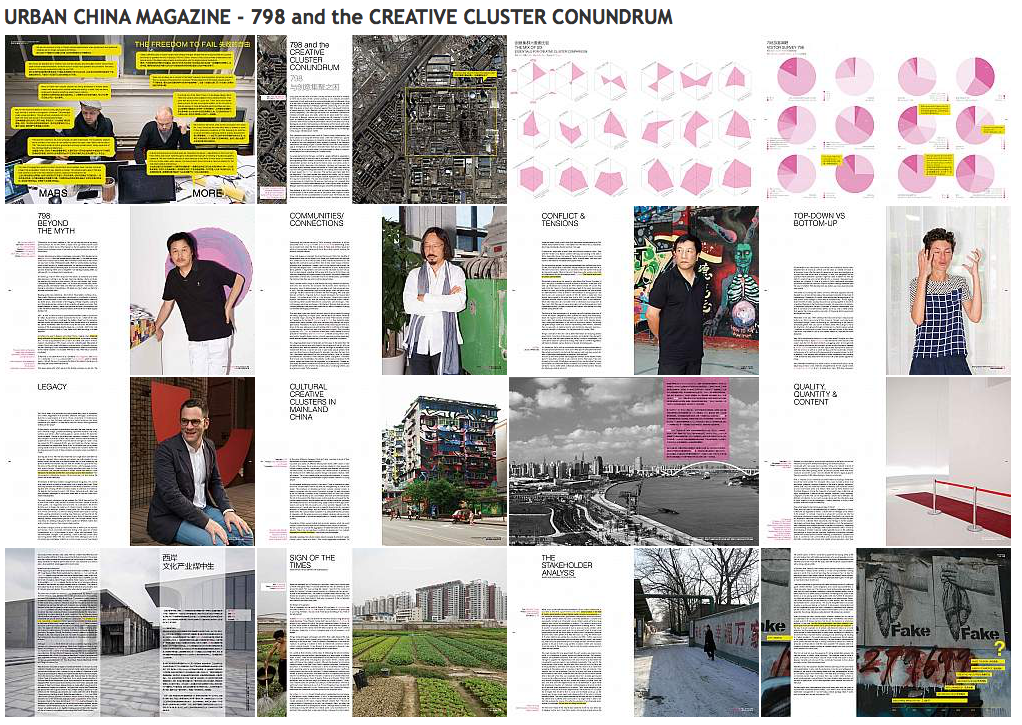
The [CITY = MUSEUM strategic planning project] is based on extensive research of the heyday of 798, as presented in the September special issue of Urban China Magazine. Through interviews of key figures and analyses of new creative clusters the challenges planning China's many new creative clusters are analyzed. The project invited OMA, McKinsey, CAFA, AIM and several other leading design firms to partake in a design relay for the long term future of the 798 Art District.
INTERVIEWS: Huang Rui, Shiqun, Tinari, Bernell, Leanza
INTRODUCTION
798 and the Creative Cluster Conundrum
中文在下面
By Neville Mars, 向798学习-- 何新城
Long gone are the days of artists rubbing shoulders with factory workers on their way to work; of red curtains covering up Mao statues; of prudish censorship of body parts and other trivial sensitivities; and of bulldozers rolling in at the crack of dawn to level another art village. Long gone are the Wild Wild West (read East) days of Beijing's tight-knit, unassuming art community. Well, long gone, at least when observed against the compressed timeframe of events defining China's fledgling modern art scene. Ten years ago the arrival of a formidable contemporary Chinese art market was a new reality, while only ten years earlier the currency of success in Beijing’s underground art scene was still measured in political vigor. Art reflects society, and the speed at which it travels. In perfect synchrony with China's societal transformations, the art scene shed much of its ideological proclivities. Relinquishing confrontational performances and similar regime-critical work, collective activism soon gave way for individuals focused on making the more tangible and aesthetic art demanded by an increasingly China-hungry international art market.
This inevitable boom and bust cycle of China’s young contemporary art scene played out during the first few years of the new millennium, against the backdrop of a still serene and industrial-looking factory 798. Grassroots in nature at first, the subsequent heavy-handed co-opting of the Dashanzi International Art Festival roughly coincides with the end of this initial phase of organic emergence; a brief period of transformation that not only positioned Chinese art firmly on the world stage, but reintroduced a culture of creativity, self-expression and critical thinking to Chinese society.
In a pressured economy that was — and still is — largely defined by pragmatism, the conceptualizing of anything new is dominated by production-orientated and engineering-driven notions of innovation. As such, artists held a uniquely independent position during those formative years, and were pivotal in rekindling a public discourse. From festivals, biennials and triennials, the exchange largely revolved around the themes of China’s new urban age and concerns with a government geared towards city building and society building at hyper speed. As Phil Tinari recounts, “The narrative was there, right from the beginning”. Relevant and urgent, not in a small measure because 798 was built on, highly unstable legislative soil, not suitable for long-term investments.
Exacerbated by the constant threat of concrete plans to rebuild the 798 area as a technology hub modeled after Zhongguancun, or what is often referred to as China’s Silicon Valley and Beijing’s rapid encroachment, pushed along by a forceful real-estate bubble.
Fast-forward to the 798 of today, and its three million visitors annually, combined with a yearly rental turnover of 100 million RMB implies a certain level of stability for the now-established art zone’s future. The threats the area faces are no longer so acute and immutable in nature — the plans for a second Silicon Valley have since been shelved — nonetheless, uncertainty remains. Without any clear new directive for the area's future, many leases have been cut back to a year-by-year basis. Meanwhile, the growing appeal of the area has triggered several new concerns. Inspired by its rapid development, more abstract objectives — such as tripling the floor area ratio — have now been floated. Equally dubious, such a densification would inevitably seek to exploit the vast commercial growth the area has seen over the past decade.
The pervasive onslaught of commercial activity — not unlike the harsh commercialization of Beijing’s historic center — has become a major eyesore, eroding the area’s core qualities and hampering its overall functionality. Continuation of uncoordinated block-by-block upgrades, even with the noblest of intentions and beautiful architecture, can nonetheless further undermine the quality of the area. In short, 798 is suffering from its own success, a contradiction that makes planning any alternative future all the more challenging.
Today, creative zones and creative industries are prominently featured in national policy guidelines. Optimistically, the zone’s management now embraces and endorses the notion that the planning of 798 is crucial in safeguarding the area’s core values and giving better coherence to its ongoing development. But what kind of development will follow? The 798 area has matured into the undisputed poster child of China’s contemporary art scene and its success has oozed out far beyond its core area. Its convoluted origins firmly rooted in international exchange and investment, and with several galleries operating at an international level, 798 has become the mainstay of Chinese contemporary art in the world. This bedrock of high art, in turn, has spawned a rich ecology of creative industries-related programming — not to mention many, many coffee shops. The full cycle of gentrification of China's first organically-evolved creative cluster is complete.
Seeding the Creative City
When it comes to planning China’s new creative clusters, what insights can be gleaned from those early, halcyon heydays of 798? On a superficial level, the answer to this question is simple: not much. Ever since 2006, when the creative industries debate really took hold in China, national-level ambitions have steadily trickled down to local governments. Many diverse and highly-specialized creative zones have since been built across the country. From film and TV clusters, for example, to RnD centers, to marketing and design incubators, even entire Silicon Valleys have cropped up inconspicuously amidst the factory floors of Shenzhen. However, as the result of distinct planning by governments and companies, they represent a fundamentally different model from the path of organic evolution followed by 798. It is fair to wonder: Was 798 not only the first major grassroots creative cluster, but is also doomed to be the last? And, if it is indeed the last of its kind, would that really matter? Tencent in Shenzhen comfortably rivals the most innovative companies of Northern California. It’s an observation that gives rise to the central question of this magazine: Are there any distinct differences between planned and unplanned districts, the roles they play and the urban qualities they generate?
To this end, problems relating to an increasingly diffused 798 community may shed light on a significant distinction. Without a clear community, who gets to have a say in its future, or even define the content that makes up the area today? It is too simplistic to suggest that 798 no longer has a local community; rather, the area has become a platform for many different communities, albeit casual and unspecified ones. The tacit mission, however, of free expression, artistic experimentation and critical debate that once unified the area’s artistic community has been lost. Although current tenants and management may share an ambition to promote art — specifically quality art — as the foundation of the 798 area, without a distinct community that embodies and defines this ambition, who will determine what constitutes quality, or even art?
Self-organization is powerful in responding to the challenges of plurality. The district's early settlers arrived with extremely pragmatic objectives: namely to occupy large spaces for low rents. As Beatrice Leanza reminds us: “There was no ideology other than opportunism, no legacy to build on”. And yet, the fleeting collective aspirations of those early settlers grew into a powerful nostalgia that even today continues to attract the crowds, sell art and drive up rents. This lingering impact of the initial community may be the true legacy of 798. At the very least it underscores the role a community can play. Beyond a mere social seed that proved capable of blossoming into a central hub within the global art network, it was the medium of a prevalent narrative that still holds sway today. Simply put: community constitutes content! If we can learn anything from 798’s early days, it is that its value was vested in its personal networks, or what marketing professionals would call 'human capital'. Acknowledging the role a community can play in nurturing content and building networks raises two fundamental questions when planning China’s new creative clusters. First, can we ever plan what is intrinsically unplanned? And if so, what should creativity entail in China today?
There is much at stake for China in trying to solve the creative cluster conundrum. At a fundamental level, creativity is deemed as something that we can nurture, amongst other initiatives, through the planning of artistic hubs. Following this reasoning, in turn, this can coax an economic shift away from the secondary sector of industrial production towards a tertiary sector of services and innovation. In the dream scenario of creative cluster planning, the sturdy and elegant structures of former factories become affordable lofts and studio spaces of a new creative community. As this community grows in prominence and prosperity, the once overlooked and undervalued neighborhood gains a broader appeal, marking the start of a natural process of gentrification.
In this scenario, the ultimate goal is the seeding of the 'creative city', a conceptual construct inhabited predominantly by the 'creative class' (as advanced by Charles Landry and Richard Florida respectively). The residents of such a city form an intricate network of creative thinkers and doers, supported by progressive and collaboration-prone governance. Within this construct, actors can address highly complex problems that require integrated, multi-stakeholder solutions that could range from poverty relief, to congestion; the environment to the development of China’s rival to the iPhone.
The resulting cities will be more competitive and have higher economic outputs. With cultural export as its biggest earner and no less than 10% of its population employed in the creative sector, the US, in this respect, is still the leading example. Referring to the American context, Florida argues that cities adhering to this model foster what he calls 'the three Ts': Talent, Tolerance and Technology. That is to say, a highly-educated, socially-diverse and open community, supported by the technological infrastructure needed for enterprise and culture to flourish. However generic such a strategy may be, more and more these two concepts of creativity have become the metaphors behind steadily more sophisticated relationships between government, business and society. Emerging are new, powerful hybrids that bridge public and private entities; for-and not-for-profit enterprises; top-down and bottom-up incentives. These are the hallmarks of a creative city.
In light of the success with which creative clusters have been established over the last decade in cities across the world, one could argue that their planning may not, in fact, pose such a conundrum. Seemingly with ease, the so-called 'Bilbao effect' quickly rendered a once struggling industrial backwater into a leading global cultural hotspot, mystifying planners and inspiring mayors the world over. Today, the city of Bilbao has flourished — or rather gentrified — into one of Europe’s most vibrant cultural destinations.
Less well-known, however, is the inescapable truth that Bilbao is not simply the result of blunt investment in infrastructure, draped around one of the world’s most iconic museums. Rather, the Guggenheim was merely a first incentive to formulate a longer-term strategy of community-orientated investments in education, new employment opportunities and other social infrastructure. In a nutshell: the 'softer' side of city planning. As a result, beyond a stunning tourist attraction, the museum has served as an icon of the city's new collective identity; a beacon for a new economic future for the local community.
The 'Bilbao effect' has also been pursued and its formula implemented — rather effectively, in fact — by cities across China. In this volume, we examine the impact of Shanghai’s recent West Bund development (p. x), as well as the civic influence of Guangdong’s Times Museum (p.x). That said, putting this formula into practice didn’t come about without first stripping it down to its bare bones. As is so often the case in China's urban development, when the abstract ambitions of the central government — in this case the desire to stimulate a knowledge economy — find tangible and practical business models to support their instigation, things can move very fast indeed, as outlined in XiaohuaZhong and Yifei Li’s analysis of the Bridge 8 in Shanghai.
The combination of central economic planning and market-driven flash urbanization has undoubtedly accelerated the integration of creative cluster concepts in China’s planning culture. Over the last eight years, large swaths of purple rectangles have peppered up urban master plans of bustling megacities and desolate towns alike. Denoting areas earmarked for future creative industries, typically they’re lavishly sprinkled around the edges of new developments. Exploiting the term’s inherent ambiguity — that stems from the seemingly casual merger of 'creativity' and 'industry' — this modern urban program has been applied as a perfect placeholder to any area of an uncertain future. In such master plans purple seems to imply that at any given time, either of these arguably disparate activities would suffice for said suburban development.
Capturing the attention of developers and city officials alike is creative clusters’ potential for branding cities. Big museums at the center of large urban regeneration projects developed in close public-private partnerships have elevated the profile of some truly remote projects (think Guangzhou’s Times Museum, p. xx ). However beautiful and impressive these developments may be, as a model of creative cluster planning they introduce a final, quintessential distinction from the organic process represented by 798. Quite aside from the absence of a core community and its inherent potential to grow social networks, drive new ideas and foster public discourse, these new projects are generating radically different urban spaces. For all of its despised clutter, tackiness and messiness, 798 still offers a truly unique urban experience.
Indeed, the results of an exclusive series of interviews carried out by students of CAFA (p. XXX) reveal this urban context to be the main quality that visitors appreciate about 798. The area’s plazas and small alleyways form a comprehensive urban system of an intricacy and diversity that can only be found in historic neighborhoods able to steadily grow more elaborate over time. In this urban system, the factories and galleries — be they high-end or low-end — are spun together to form a continuous indoor-outdoor art space. The pitstops on visitors’ journeys, it is arguably the public space in between, the wandering from one destination to the next that defines their experience.
CITY = MUSEUM
Creativity itself has, since the birth of the 798 Art District, most fortunately seen an explosive maturation and diversification. Sadly, the same can not be said about China’s urban landscape and how it is planned. Indeed, 798 has evolved into something akin to an open-air museum which in scale can rival any of the mega art institutions currently under development in China. Unlike those large insular projects, however, its public domain offers room for random encounters and un-orchestrated interactions that typically happen in intricate undefined and unregulated spaces. These are the type of spaces that provide potential for personal expression and — counterintuitively — provide a sense of place.
However challenging planning them may be, this is precisely the urban quality that new creative clusters must aim to seed. As Chen Qianqian of the Department of Urban Planning at Beijing University so eloquently explains, “The emergence of creative clusters around China’s cities will give the people a chance and a place to explore their individuality”. The first strategic collaboration between the area’s management and its tenants is undeniably a step in the right direction. The project, initiated by one of the art district’s earliest residents, artist Huang Rui, has sought strategic input from local and foreign experts. The project — led by architecture offices MARS + MORE — applies a new time-based format for multi-stakeholder collaborations to address the social and spatial challenges 798 faces, as introduced in this magazine. Working with the local community, as well as 8 internally renowned design firms and think-tanks, the results are to be presented in the upcoming issue of Urban China. Starting with 798, the project is not aiming for a finite short-term solution, but rather reimagines ways of approaching creative cluster planning, holistically, together. In the words of one the art district’s involuntary founders, Huang Rui, “Solving 798 is solving creative industries in China”.
798与创意集聚之困
何新城
艺术家与工人一起赶路上班的日子早已过去了; 红帐掩盖毛泽东雕像的日子过去了; 对裸露和其他琐碎敏感事物的严格审查过去了; 推土机在破晓时分开动,拆迁艺术村的日子也过去了。北京密不透风、不事张扬的艺术社区中那些“腐化堕落的西方生活”也过去了。至少纵览中国羽翼渐丰的艺术界,这些都已经成为了过去时(见海报)。十年前,一个强大的中国当代艺术市场已然到来,而再往前上溯十多年,北京地下艺术圈还在以政治活力论成败。艺术反映现实,也反映社会进步的速度。与中国的社会转型完美同步,艺术圈中也产生过很多意识形态。放弃斗争表演及政治批评,集体行动主义很快向更着重于具象和审美的个体让位了,这也是中国嗷嗷待哺的国际艺术市场的要求。
当798还是一片宁静的工厂区时,中国年轻的当代艺术就已经不可避免地在新千年的最初几年中荣枯转换。 起始于草根本质,随后被严厉指责的大山子国际艺术节大致结束了它有机生长的初始阶段。这个短暂的时期不仅确立了中国艺术在世界舞台上的牢固地位,还创造出一种创新的自我表达方式和对中国社会批判性思考的文化。
在曾经的,并且在现在依然非常实用主义的经济下 ,一切新概念的生成都以生产导向,以工程驱动概念创新为主。因此,艺术家们在启蒙的几年内占据了一个独特而独立的地位,在产生新公共话语上有着至关重要的作用。从各大活动、双年展和三年展来看,这种交流主要围绕着中国的新城市时代和高速转向城市和社会建设的政府。如田霏宇所说,“从一开始故事就是这样了”。情况刻不容缓,因为北京的迅速扩张不是小打小闹,而是被有力的房地产泡沫胁迫,试图将798重建成为一个像中关村一样的科技中心,而后者通常被称为中国的硅谷。
跳转到今天的798,每年300万人次的游客量和100万元的年租金营业额暗示着这个建成的艺术区在未来一定程度上的确定性。这个地区面对的威胁不再从本质上尖锐而无法调和,第二硅谷的计划亦已然搁置,但尽管如此,不确定性仍然存在。没有该地区未来发展的明确指令,很多租约都被削减至逐年结算。同时,这里增加的吸引力已引发了一些新的担忧。受其快速发展的启发,更抽象的目标,比如提升至现在三倍的容积率,就已经在实行。同样可疑是,这样的高密度将不可避免地榨取这里在过去十年中巨大的商业发展成果。
商业活动的冲击无处不在,就像北京历史中心的严重商业化那样,已让人无法直视,它侵蚀了这里的核心特质并阻碍了整体运作。不协调的,逐个地块的更新还在持续进行,即使意图是美好的,建筑也美轮美奂,却进一步破坏了地区特质。总之,798被自己的成功桎梏,这个矛盾使未来发展的任何其他可能更加具有挑战性。
如今,创意区和创意产业凸显在国家政策的指导方针中。乐观地看,该区域的管理层现在认可并支持这个理论,即 798的规划对维护该地区的核心价值观,并赋予其可持续的发展至关重要。但是将来会有怎样的发展? 798区已发展成为中国当代艺术领域无可争议的典范,它的成功对周边的辐射远远超出其核心区域。其错综复杂的起源根植于国际交流和投资,多个画廊在国际层面上运营,798已经成为中国当代艺术在世界上的中流砥柱。高雅艺术这个基石,反过来又催生了丰富的,与创意产业相关的功能生态,更不用说数量巨大的咖啡馆了。中国第一个自然进化的创意集群,其分化已然完成。
孕育创意城市
规划中国新的创意集群,从798早期宁静的全盛时期中能得到什么启示? 从表面上看答案很简单:没有多少。自从2006年,创意产业的争论在中国发生,国家的雄心逐渐稳固地扩散到地方政府。许多不同的,高度专业化的创意区从那时开始已在全国各地建成。从电影电视业聚落到研发中心,到孕育营销设计,甚至整个硅谷都不为人察觉地在深圳的工厂车间中出现了。然而,由于政府和企业的不同规划,这些创意园区代表了一种与798的自然演化截然不同的路径。怀疑是自然而然的:如果798不仅仅只是第一个大型草根创意产业集群,那么它会是最后一个吗? 而且,如果它的确是最后的幸存者,这真的重要吗? 深圳的腾讯公司可以轻松与北加州任何最具创新性的公司媲美。这个观察产生一个问题,产业园区所扮演的角色和由它们而衍生的城市特质,在计划内和计划外的地区是否有着显着差异?
说到这里,日益扩散的798社群或许可以揭示一个显著的差异。如果没有一个明确的社群,谁能在未来有发言权?谁能定义构成这片区域的内容? 说798当地社群不复存在太过简单了; 相反,这片区域已成为许多不同社群的平台,虽然其中很多是随意而不确定的。然而,这些缄默的使命、自由的表达、艺术实验和批判性的辩论,在最初的艺术社群统一时就已经丢失。尽管目前的租户和管理者也有一起促进艺术发展的雄心,特别是作为798区基础的优质艺术,可是没有明显象征和定义这种雄心壮志的群体,谁能决定怎样的艺术是优质的,甚至什么是艺术?
自发组织面对多元化的挑战时是强有力的。这里的早期定居者有非常实际的目标,即用低租金就能占据很大的空间。就像毕月提醒我们的一样:这里没有思想,只有机会主义,没有任何历史传统可以传承”。然而,这些早期移民短暂的集体愿望已变成一种强烈的怀旧之情,即使到今天仍然能够吸引游客、销售艺术品和哄抬租金。这种由社群而发,挥之不去的影响可能才是798的真正价值,它起码强调了社群可以扮演的角色。不仅仅是社区被证明其有能力绽放成全球艺术网内的中央枢纽,它仍然普遍地支配着今天的媒体。简单地说:社区构成内容!如果我们能向798初期学习些什么的话,学习的就是这种社区为个人关系网提供的价值,即市场营销专业所说的“人力资本”。规划中国新的创意集群时,明确角色的社区可以培养内容和人际网络。这就出现了两个基本问题。首先,我们是否可以策划计划外的内容?如果可以的话,创造力在当今中国意味着什么?
试图解决中国创意集群发展的难题有很多关键要素。从最基础来说,创造力被视为一种可以通过规划设计艺术中心或其他方法培养的东西。根据这一推论,反过来,这可骗得一场从工业生产的第二产业转向服务业和创新的第三产业的经济转变。在规划创意集群的美梦中,曾经工厂坚固优雅的结构,成为一个新的创意社区中便宜的跃层办公空间和工作室。随着社群的成长繁荣,一度被忽视的临近区域产生了更广泛的吸引力,一场自然而然的士绅化开始了。在这种情况下,最终目标为“创意城市”概念的生成,这是一个主要由“创意阶层”(分别由CharlesLandry和RichardFlorida提出)居住的概念构建物。这里的城市居民形成一个由创新的思想者和实干家组成的,管理先进而人们彼此乐于合作的复杂网络。在这个构建中,参与者可以解决非常复杂的问题,这些问题的解决需要一个能综合多方利益的方案,范围从扶贫到治理拥堵,从环境问题到发展能与“iPhone”竞争的企业。
由此产生的城市将更有竞争力,并具有更高的经济产出。随着文化出口成为其最大的收入来源,而且其人口在创意部门的就业不低于10%,美国在这方面仍是领先的例子。在谈到美国时,Florida认为,城市秉承这种模式产生了他所谓的“三T”:人才,宽容与技术。这是一个由企业和文化蓬勃发展所需的技术和基础设施支持的高学历、社交多样和开放的社会。不管这个策略有多泛泛,这两个关于创意的概念已经逐渐成为政府、企业和社会之间日渐复杂关系的隐喻。沟通公共和私有实体的,崭新强大的综合体正在兴起;盈利或非盈利的企业正在兴起;自上而下和自下而上的激励机制正在兴起。这些是都是一个创意城市形成的标志。
反观全球范围内,过去十年里那些在创意集群中取得成功的城市,可以说,他们的规划可能不会在事实上造成这样的难题。城市的发展看起来轻而易举,所谓的“毕尔巴鄂效应”迅速使一个曾经步履维艰的工业死水潭成为一个领先的全球文化热点,将策划者们供上神坛,激励了世界各地的市长。如今,毕尔巴鄂市的繁荣,或者说城市更新成为欧洲最具活力的文化旅游目的地之一。但一个不为人所知却无法逃避的事实是:毕尔巴鄂的成功并不是直接的基础设施投资带来的简单结果,虽然它享有世界上最具代表性的博物馆之一;相反,古根海姆仅仅是一个规划长期社区导向投资的第一个诱因,这些投资还包含教育、新的就业机会和其他社会基础设施。一言以蔽之,就是城市规划“柔软”的一面。结果博物馆不仅成为了一个迷人的旅游圣地,更成为了一个城市新集体个性的象征,一座为当地社区照亮新的经济未来的灯塔。中国各地的城市追捧“毕尔巴鄂效应”,像公式一样推行它的政策,事实上还相当有效。在这一期中,我们考察了上海近期西岸开发的影响和广东时代美术馆对公民的影响力。也就是说,把这个公式付诸实践还要有深度解析。中国的城市发展经常发生的一幕,是当中央政府的抽象的雄心(此指激发知识型经济的愿望)找到具体而实用的商业模式来支持他们的想法时,事情确实可以发展得飞快,就像钟晓华和李亦非对上海的8号桥的分析中总结的一样。
中央经济计划和市场导向的快速城市化结合,无疑加速了创新集群概念在中国的规划文化中的融合。在过去的八年里,大片的紫色的长方形撒遍了城市规划图,无论是繁华的大都市还是偏远的城镇。专门面向未来的创意产业领域通常大肆占据了各地新开发项目的边缘区域。当一片区域的未来悬而不决时,这种现代的城市功能被作为一个完美的占位符号运用。利用其固有的模糊性, 源于“创新”和“产业”看似随意的并置,这个术语的使用意味着在任何时间,其中任意一些完全不同的活动,都足以符合已确定的郊区开发计划。
吸引开发商和城市官员注意力的是创意集群推广城市品牌的潜力。城市中心大型更新项目中公私群体密切合作的大博物馆确实提高了一些非常偏僻的项目的档次,但不管这些开发项目有多美丽动人,作为创意集群规划的模型,它们存在和以798为代表的自然生长发展区域决定性的、显著的差别。 缺乏核心的集体社群,缺乏内在产生社交网络、驱动新想法和培养公共话语的潜力。这些新项目正提供着截然不同的城市空间。尽管局促老套又乱糟糟被各种鄙视,798仍提供了一种独特的城市体验。事实上,中央美术学院学生?的独家系列访谈披露了这种都市环境是游客主要欣赏的798特质。这里的广场和小胡同形成一个错综复杂的城市综合系统,这种复杂性和多样性是随时间成长的、精巧的历史街区所独有的。在这个城市体系里,工厂和画廊,无论是高端还是低端,交织在一起,形成一个连续的室内外艺术空间。它们是游客在行程中驻足的地方,从一个目的地游荡到下一个目的地时,其中的公共空间决定了他们的体验。
城市=博物馆
有幸的是,自798艺术区的诞生起,创新本身即经历了爆炸性的成熟化和多样化。不幸的是,中国的城市景观和规划并不是同步发展的。事实上,798已经发展成一个露天博物馆,其规模可以媲美中国目前任何一个开发中的大型的艺术机构。不止如此,与那些孤立的大型项目不同,798的公共领域为偶遇和随机的互动提供了空间,这种互动通常发生在复杂的非正规空间。正是这些空间为个人表达提供了可能,并且是非直觉的——提供了一种场所感。
不管规划起来有多难,这些恰恰是新创意集群必须孕育的城市品质。正如北京大学城市规划系陈倩倩的说法,“创意集群在中国城市中的兴起会给人们机会和场所去探索自己的个性”。管理者和租户之间首次的战略合作无疑是朝着正确方向迈出的一步。该项目由早期的艺术区居民之一艺术家黄锐发起,向本地和外国专家寻求策略。由建筑事务所MARS+MORE带领的这个项目,为多方利益者共同合作,运用一种全新的方式解决798面对的社会和空间问题,就像本杂志介绍的这样。讨论从798开始,但这个项目的目标不是有限的短期解决办法,而是重新构想讨论研究创意集群规划的整体方式。按这个艺术区的非正式的发起人之一黄锐的话说,“解决798的方法就是解决中国创意产业方法”。
“创意聚集区在中国各个城市的出现给了人们拓展个性的机会和空间” 陈倩倩,北京大学城市与区域规划系.
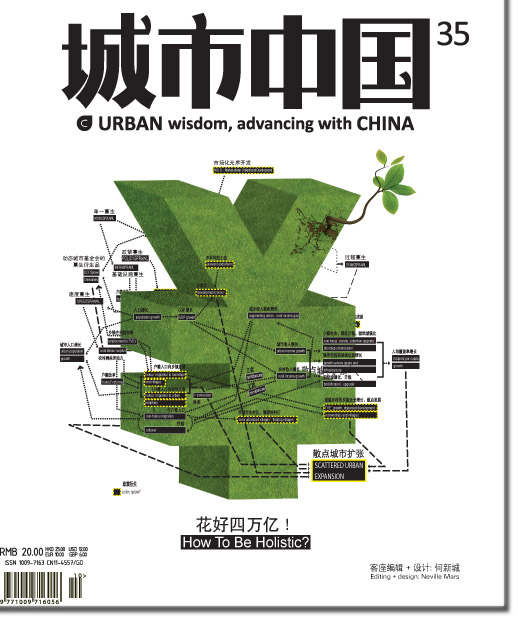
Urban China #35
Special issue Urban China: How to be holistic? 花好四万亿!
Edited by Neville Mars, with contributions by the DCF and numerous international designers and institutes.
As the global recession expanded to include China, it in turn prepared its own stimulus package. An impressive 4.2 Trillion RMB was allocated to keep the economy moving at a Chinese pace. But unlike so many Western nations struggling to determine how the money should be spent, China has formulated a stringent to-do list with a strong urban focus. Nation building through city building. Yet it remains unclear how the individual bullets on this list - infrastructure, housing, environment, etc. - should relate to each other. The vision for a ‘better city’ can only be conceived through an integrated vision that includes all the scales of urban life. After thirty years of accelerated growth a top-down approach of big answers can no longer suffice. This special issue of Urban China examines the contradictory choices China faces, step by step mapping out an holistic approach from policies to individual people.
Download the Magazine Urban China 城市中国 as PDF
Or view PDF Slideshow on Scribd (not available in China).
Download special Insert Introduction and Poster
Download Hangzhou photo essay and Dream Survey Poster
Extended articles available here: http://supersatellites.burb.info/
Harmonizing the Hybrid 和谐二元体
Neville MARS 何新城
Market capitalism in its purest form received a deathblow in 2008. Not because of the global economic melt-down, but because of the sudden erosion of its underlying ideology. Alan Greenspan, the oracle of the free market, conceded incompetence: “The idea of the last forty years, that the markets were best to regulate themselves was flawed [...] some of the critical pillars underlying market competition arguably, have failed”.
In the months that followed stimulus packages took the world by storm. Words like bailout were uttered by the starkest economic conservatives, while American liberals suddenly opposed the idea of government spending fearing it might just line the pockets of those who corrupted the system in the first place. The world’s political financial logic turned upside down. The contradictions in the economic belief system brutally revealed themselves in sheer apathy. Billions of dollars were allocated to rescue the economy, but no clear objective to spend the money could be formulated.
Warnings
Much critique has also been raised about China’s 4.2 trillion RMB stimulus package. It might be too impulsive, difficult to implement and indeed too expensive at a time of a real-estate slow-down for local governments to cough up 3/4 of the sum. However, assuming the effectiveness of this measure, there is a more profound question we should raise. Why must an impressive 8% annual growth rate be upheld in the first place? This decade old concept aimed to artificially safeguard employment - and with it stability - flies in the face of China’s move to a market economy, moreover it contradicts the stated ambitions to prevent its economy from overheating. The task of this balancing act is undeniably daunting, yet it seems clear the central government will invariably opt for faster growth over a slow down. The extensive crisis in the West should provide a strong warning, yet fundamental questions about China’s future are still not addressed.
Unlearning Modernity
A strong economy depends on fast urbanization. Yet many basic problems can be contributed to the accelerated pace of construction, ranging from housing shortage as a result of large-scale demolition policies to rampant speculation. After precisely 30 years of flash urbanization we need to ask if this is still a desired, even acceptable model. We need to assess the specific qualities of high-speed growth and the type of environments and society it produces. Unfortunately there are no precedents. We cannot evaluate the direction of this fast moving train based on the conditions it left behind 30 years ago. Nor can China determine its intended direction based on what other countries have achieved. In three decades the world has dramatically changed. Linear economic development along the lines of western industrial nations will no longer suffice. The minute interconnections between individual prosperity and collective (even global) progress have surfaced. This is true for the crises in the housing market, but equally for the augmenting environmental pressures felt particularly at an individual level in the emerging economies. So far government initiated urbanization has been an effective tool to offset mounting social tensions against bright new developments. In a magical show of central might the outside world (and China’s hinterland), were presented with the highest achievement of three decades of top-down planning and orchestration. For a month in August the air was clean, even the rain was controlled, but soon after smoggy clouds rolled back over Beijing. Similarly actions to tackle the post-Olympic slowdown were confronted with the harsh reality of a real-estate slum. The limits of artificial growth have been reached.
Preconditions
In addition to the strategic contradictions, there are plenty of practical challenges facing China’s stimulus package. But unlike Wall Street's demand for a blind check, at least China has been extremely precise in defining how it wants to allocate the money. The targets primed for investment range from society and livelihood (housing security, medical care and education), to infrastructure (rural infrastructure, the power grid, railways, highways and airports), the environment (ecological protection and water treatment), to post-disaster reconstruction. All are hands-on projects with a clear directive and purpose that should help give nuance to China’s ongoing development. This method of nation building, based on large-scale incentives coupled with a careful release of bottom-up entrepreneurialism has been the success formula from the beginning of the reform era. It is, for lack of a definition, the best way to describe the socialist market hybrid. With Western capitalism in disrepair China’s stimulus package presents a real opportunity to mindfully define the socialist market economy. But there is a precondition: that we consider and map how it will likely shape society and landscape.
One Nation, Two Forces
Unlike three decades ago, China’s map can no longer be approached as a tabula rasa*. Today, China’s economy - as any where else - is entirely interconnected with its urban geographic conditions. Unfortunately, the success of the socialist-market hybrid is increasingly at odds with the blurred rural-urban hybrid it produces. The new landscape is complex and dynamic; ill-suited to investments as a blunt listing of isolated objectives. Precisely the awe-inspiring gains that have been made, now dictate a shift towards coordinated spatial-economic planning. Parallel to the top-down economy and its planning apparatus a powerful bottom-up economy has generated a pervasive organic growth. Two worlds that fear each other, yet feed off each other. While China macro-plans its cities and icons, aggregated micro-projects expand the urban landscape in the form of more Market-driven Unintentional Development, or MUD* (as illustrated below).
Concealed Reality
Observing MUD formations fractures the persistent beliefs in both the grass-roots city and the orchestrated landscape. At street level
China's new urban realms look perfectly micro-planned while the same polished island developments at the scale of the region merge together to reveal macro-organic systems. The biggest challenge for China’s next phase is to consciously address these two forces as a single dynamic. This is difficult, not just because of the development speed, but because of the counterintuitive reality China is producing. Increasingly slick and superficially modern, the organic nature of its urbanization remains concealed. As a result policies and planning measures are rational only to the extent that they address what is seemingly in front of us today. Unresponsive to an inevitably different reality tomorrow they ultimately contribute to the problems. Spatially fragmented, socially divided the schisms that characterize China’s urban landscape widen. The window of opportunity is closing.
Defying Patterns
While the building industry has evolved, tremendously accelerating its operations to meet the demand for new cities, a comprehensive design, research and education system needed to answer how best to produce the future landscape is still not in place. The components of China's cities are designed in days;
the ensuing MUD configurations then fixed for decades. Yet the economy is no longer just a prerequisite for urbanization, instead urban patterns are increasingly shaping future economic potential. The long-term effects can hardly be overestimated. A comparison between the spatial constitution of American, Asian and European cities reveals the impact on energy use, productivity, creativity, even crime rates and happiness. Designing the city beyond the scale of the compound or development zone is becoming as difficult as harmonizing society itself.
But unlike the rest of the world, China can anticipate another three decades of growth; a unique opportunity to coordinate its scattered organic expansion. Embracing the dynamic nature of the city, density itself becomes an effective tool to streamline growth. We can still abandon the static and sterile layouts the state-market machine generates, if we encourage a free free market to adopt flexible urban frameworks - this is not just more sustainable but more investment-friendly in these turbulent times. Short-term economic growth might support stability, fast pace urbanization discourages developers and institutes alike to innovate and diversify, undermining the quality-driven competition we could expect as the real-estate market moves away from a suppliers’ market.
Roadmap
Any ambition to either support the economy or engineer the harmonious society hinges on our commitment to an holistic urban vision. Ironically, pre-Olympic Chinese planning can best be compared to Western medicine: fast and powerful in tackling isolated problems. Now half-way complete, post-Olympic China must start drawing on its own models, and switch from crude mega-project medication to a broader planning philosophy. This change is both urgent and drastic; its implementation needs to be both immediate and long-term. Designers can no longer hide behind the much vaunted excuse ‘endless flexibility is acceptable’ in order to survive in the Chinese market. While developers will need to accept that design is not drafting, and that the design the process is less a question of applying stylistic cues than a means to overcome the contradictions and hurdles that plague China’s development. All of us involved in the urbanization process are accomplices and we are all an integral part of the solution.
This issue of Urban China offers a roadmap to mark out a collective route to an alternative future. Based on the research by the Dynamic City Foundation and with contributions from designers and institutes from across the globe, we have produced a framework in which the individual ideas come together to form a larger conceptual patchwork. Step by step correlations are forged between the scales on which the city operates and between the components of China’s stimulus package. But be warned: it is not as straight-forward as join-the-dots, no longer as black and white as good and bad options. Instead, at every junction, we’ll need to think twice about short-term gains and long-term investment.
2008年,市场资本主义的单纯形式遭受了致命一击。原因并非全球经济的崩溃,而是基本意识形态所受的突然冲蚀。艾伦·格林斯潘,自由市场的大哲人,亦承认了能力不足:“在过去40年,相信市场最好还是自我调控的观点是有误的……某些支撑市场竞争的关键支柱,可以说倒塌了”。之后数月,各种经济刺激方案席卷全球。当最顽固的经济保守派大喊“救市”时,美国的自由派却突然反对政府大量开支,担心这只会让罪魁们中饱私囊。整个世界的政治金融逻辑似乎在瞬间颠倒,经济信仰体系的矛盾暴露。美国政府拨款数十亿拯救经济,却未有清楚的目标。
警告
中国4.2万亿经济刺激方案引来了大量争议。也许是太冲动、难以实施,而且让地方政府承担总预算的四分之三,在房地产业不景气的时刻未免牵强。然而,即使这一措施有效,我们仍需提出一个更深刻的问题——为什么一定要维持8%的GDP增长率?这一贯彻了十年之久的观念最初是为了人为地保障就业及社会稳定,但却与市场经济原则相悖、并与防止经济过热的目标冲突。不可否认,维持平衡相当艰难,但很明显,中央政府将一如既往地选择更快增长而非经济放缓。波及西方世界的危机应该是有力的警告,但事关中国未来发展的根本问题却仍未触及。
审视现代性
强大的经济倚赖于快速城市化。然而,建设的加速度导致了许多根本问题——从大规模拆迁所致的住房紧张到肆无忌惮
的市场投机。当闪电式城市化已过而立之年,我们应该问,这是否仍是人们想要的、可被接受的模式。我们需要评估高速增长的质量,以及它塑造的社会。可惜并无先例或范本。我们不能根据前30年的经验来预测这辆‘东方快车’的方向;中国也不能照搬其他已成功国家曾经的方向。30年间,世界已翻天覆地。西方工业国家线性的经济发展已经不够用。个人财富和整体进步(甚至全球进步)之间的微妙关联已浮出水面。这不仅在危机突现的房地产市场、也在新兴经济中个体承受的环境压力上升中得到体现。迄今为止,政府启动的城市化已成为一个有效工具,它成功打消了开发所加剧的社会对立情绪。而在显中央神威的魔法秀中,呈现给外国(和中国内陆)的是30年自上而下的规划与协调的最高成就。整个八月,空气清新,连雨水也受控,但不久后烟雾即滚滚回京。类似应对后奥运经济放缓的措施还遭遇了房地产市场的严峻现实。人为促增长的界限似乎已经到来。
前提
除了战略性矛盾外,中国的经济刺激方案面临诸多现实的挑战。然而与华尔街只要空白支票不同,中国在界定钱的拨配问题上非常明确。投向领域包括社会、民生(住房保障、医疗保健和教育)、基础设施建设(农村基础设施、电网、铁路、公路和机场)、环境(生态保护和水治理)以及灾后重建。这些都是有明确方针目标的实干工程,将为中国的发展带来一丝新变。这一国家建设的方法,是以大规模的刺激为基础,加上谨慎放行的自下而上的创业精神。而从改革伊始,这就被证明是成功的妙方。在没有更好的定义时,社会主义与市场经济的二元体恐怕要算最佳描述。当西方资本主义岌岌可危之时,中国的经济刺激方案提供了一次认真定义社会主义市场经济体制的良机。但这有一个前提:我们需要思考并追踪它将如何塑造社会与景观。
一国两力
迥异于30年前的是,中国地图不再是可任意作为的白板*。今天,中国的经济――与其他任何地方一样――与城市的地理条件密切关联。成功的社会主义-市场经济的二元体与它一手造成的界限模糊的城乡二元体-不幸却越来越不融合。新的城市景观复杂多变,如规划只是将孤立的项目简单排列,那么这相悖于投资有先后的特性。我们需要的是空间与投资关系相协调的规划。强大的、自下而上的经济也在广泛而体系化地生长,与自上而下的经济及其规划机制平行。尽管是两个遥远的世界,却彼此促进。当中国宏观地规划着它的城市和形像,微观项目之累加也在扩张着城市景观,以市场化无序开发的形式,或者说MUD* (如下图所示)。
隐匿的现实
观察MUD的构成会粉碎对草根城市与协调景观最坚定的信仰。在街道层面,中国新城市空间被细致规划得十分完美,而同样精致的孤岛型开发项目连绵成片,两者共同展现了宏观规划的有机体系。中国下一阶段的最大挑战就是如何将这两股力量汇聚。这很困难,不仅因为发展的速度,更由于中国有悖常理的现实。与日俱增的华丽与貌似现代的外表,城市化的有机本质却被掩盖。其结果是,政策和规划措施只会在特定范畴内合理,即今天我们所面对的问题。对明天将必然出现的情势却全无应对,它们终会沦为问题制造者。空间碎片化,社会分层化等中国城市景观的种种分立又加深了。机会之窗亦被关上。
界定形态
建筑业不断发展,疯狂地加速运转以满足新城市的需求,全面的融设计、研究及教育于一体、能创造未来景观的的系统却未出现。中国城市的组件寥寥数日即可设计出炉,但之后的MUD布局却要被固化数十年。经济不再是城市化的唯一前提,城市形态反而日益重要地塑造着经济潜力。其长期影响难以被高估。一项美洲、亚洲和欧洲城市空间构成的比较研究显示了它在能耗、生产力、创意甚至包括犯罪率和幸福感方面的作用。要超越建筑群或开发区的范畴进
行设计,与打造我们的和谐社会一样艰巨。
与世界其他地区不同,中国还可期待下一个30年的增长,以及唯一的机会去调合散点城市扩张的结果。接纳了城市的动态本质,密度便可成为让发展流畅的有效工具。我们依然可以放弃国家-市场机器安排的静态的、了无生气的布局,前提是我们鼓励一个(真正自由的)自由市场采纳灵活的城市框架――它不仅更具可持续性,在这个跌宕起伏的时代也更利于投资。短期的经济增长可能有助于稳定,快速城市化阻碍了开发商和类似机构进行革新、寻求多元,并破坏了质量导向的竞争。当房地产市场走出供方市场时,这本是我们的期待。
路线图
任何推动经济发展或让社会和谐的理想,其关键都在于我们对城市愿景的全局把握。讽刺的是,中国的前奥运规划好比西医:治疗单独病症时又快又猛。现在完成过半,后奥运中国必须开始启用自己的模式,从粗糙的超大工程疗法转向更广泛的规划哲学。这个改变既紧迫又重大;既需即刻执行也需持之以恒。规划师不能再躲在“不能不无限妥协”这类借口背后,仅仅为了在中国市场立足。规划师必须承认,设计不是画草图,设计过程也不是选用哪种风格的问题,而是克服困扰中国式地产开发的一切固有矛盾与障碍。我们大家都是城市化进程的同谋,也是解决方案不可缺少的一分子。
本期《城市中国》的路线图为我们展示了通向另一种未来的道路集合。基于动态城市基金会的研究,以及来自世界各地设计师和机构的投稿,我们构建的框架让独立的点子汇聚成了一幅更大的概念拼图。 在城市运转的不同规模之间,在中国的经济刺激方案的各部分之间,关联性一点点被塑造。但要警告的是:这并不像连线游戏那样简单,它不再是黑与白、好与坏的选择。相反,在每一个交汇点上,我们都需要对短期收益和长期投资进行反复思量。

BURB Magazine
=诡异之城十周年纪念
Concept and artwork: Neville Mars
written and edited by Adrian Hornsby and Neville Mars with DCF.
BURB is a magazine from the year 2020 that describes the life in the advanced urban setting that has emerged. Dense and intense, beautiful cityscapes have been created, but reading the articles and interviews it becomes clear cities as the result solely built on commercial forces lack many qualities. This issue looks back at the period 2010-2020 and celebrates the ten year anniversary of the 'Cunning City'. Slowly the stark reality below the surface of slick architecture and mind numbing commercialization become apparent.
PDF Slideshow: http://www.scribd.com/full/12896406?access_key=key-i3j5epal2v4clw7floe
Articles here: https://burb.info/view/BURB_MAGAZINE
Owned by neville mars / Added by neville mars / 16.1 years ago / 80927 hits / 8 hours view time
Tags
Latest Entries
-
screen 798 UC
-
cover 798 UC
-
cover Urban China 67 creative cluster conundrum 798
-
PDF and Posters Urban China 城市中国
-
Urban China 35
Contribute
Login to post an entry to this node.

